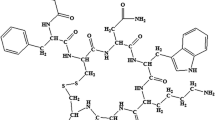Abstract
Octreotide is a synthetic analog of the peptide hormone somatostatin (SMS). A wide variety of tumors express enhanced numbers of SMS receptors, notably neuroendocrine tumors and lymphomas, but also some of the more common adenocarcinomas. Octreotide contains only eight amino acids, some of which are in the (D) configuration in order to enhance the stability of the molecule in vivo. Tyrosine and ATPA-containing analogs of octreotide have been synthesized and labeled with iodine-123 and indium-111, respectively, with the intention of targeting SMS receptor-containing tumors for diagnostic purposes. Both radiopharmaceuticals demonstrate a high sensitivity and specificity for these tumors, indicating a clinical role for these agents in management of these diseases.
Lessons can be learned from the success of these agents when designing improved antibody-based molecules. Tumor uptake of radiolabeled octreotide is very rapid, occurring within minutes of administration. Blood clearance is also rapid, such that tumors are soon visible even in areas of high blood background. An interesting finding has been the differences between the pharmacokinetics of the iodinated and indium-labeled species. Although the majority of123I-Tyr3-octreotide undergoes hepatobiliary excretion,111In-DTPAPhe1-octreotide is eliminated predominantly by the kidneys. These results suggest that the smallest possible antibody-like tracers are likely to have advantages over native immunoglobulins and conventionals Fab-like fragments.
Similar content being viewed by others
References
Wass, J. A. H. (1989) Somatostatin,in Endocrinology (DeGroot, Leslie J., ed.), W. B. Saunders, London.
Bauer, W., Briner, U., Doepfner, W., Haller, R., Huguenin, R., Marbach, P., Petcher, T. J., and Pless, J. (1982) SMS-201-995: a very potent and selective octapeptide analogue of somatostatin with prolonged action.Life. Sci. 31, 1133–1140.
Krenning, E. P., Bakker, W. H., Breeman, W. A. P., Koper, J. W., Jooij, P. P. M., Ausema, L., Lameris, J. S., Reubi, J. C., and Lamberts, S. W. J. (1989) Localisation of endocrines related tumours with radioiodinated analogue of somatostatin.Lancet i, 242–245.
Bomanj, J., Ur, E., Mather, S. J., Ellison, D., Moyes, J., Grossman, A., Britton, K. E., and Besser, G. M. (1992) A sintigraphic comparison of 123-I meta-iodobenzylguanidine (MIBG) and an 123-I labeled somatostatin analogue (Tyr-3-octreotide) in metastatic carcinoid tumours.J. Nucl. Med. 33, 1121–1124.
Bakker, W. H., Krenning, E. P., Wout, A., Breeman, W. A. P., Koper, J. W., Jooij, P. P. M., Reubi, J. C., Klijn, J. G., Visser, T. J., Docter, R., and Lamberts, S. W. J. (1990) Receptor scintigraphy with a radioiodinated somatostatin analogue: radiolabelling, purification, biologic activity and in-vivo application in animals.J. Nucl. Med. 31, 1501–1509.
Bakker, W. H., Albert, R., Bruns, C., Breeman, W. A. P., Hofland, L. J., Marbach, P., Pless, J., Pralet, D., Stoltz, B., Koper, J. W., Lamberts, S. W. J., Visser, T. J., and Krenning, E. P. (1991) [111In-DTPA-d-Phe1]-Octreotide a potential radiopharmaceutical for imaging of somatostatin receptorpositive tumours: synthesis, radiolabelling and in-vitro validation.Life Sci. 49, 1583–1591.
Reubi, J. C., Kvols, L., Krenning, E., and Lamberts, S. W. (1991) In vitro and in vivo detection of somatostatin receptors in human malignant tissues.Acta. Oncol. 30, 463–468.
Ur, E., Mather, S. J., Bomanj, J., Ellison, D., Britton, K. E., Wass, J. A. H., Grossman, A., and Besser, G. M. (1992) Pituitary imaging using a labelled somatostatin analogue in acromegaly.Clinical Endocrinology 36, 147–150.
Durbin, H., Milligan, E. M., Mather, S. J., Tucker, D. F., Raymond, R., and Bodmer, W. F. (1988) Monoclonal antibodies to placental alkaline phosphatase: preclinical evaluation in a human xenograft tumor model of F(ab′)2 and Fab fragments.Int. J. Cancer 2(Suppl.), 59–66.
Winter, G. and Milstein, C. (1991) Man-made antibodies.Nature 349, 293–299.
Reubi, J. C., Perin, M., Rivier, J., and Vale, W. (1982) High affinity binding sites for somatostatin to rat pituitary.Biochem. Biophys. Res. Comm. 105, 1538–1545.
Glockshuber, R., Malia, M., Pfizinger, I., and Pluckthun, A. (1990) A comparison of strategies to stabilise immunoglobulin Fv-fragments.Biochemistry 19, 1362–1366.
Ward, E. S., Gussow, D., Griffiths, A. D., Jones, P. T., and Winter, G. (1989) Binding activities of a repertoire of single immunoglobulin variable domains secreted fromE. Coli.Nature 341, 544–546.
Author information
Authors and Affiliations
Rights and permissions
About this article
Cite this article
Mather, S.J., Ur, E., Bomanji, J. et al. Radiolabeled octreotide. Cell Biophysics 21, 93–107 (1992). https://doi.org/10.1007/BF02789481
Issue Date:
DOI: https://doi.org/10.1007/BF02789481




